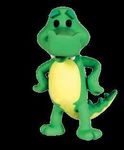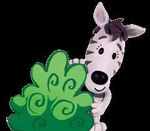Get ready to ROAR with - CBeebies Every weekday at 3:30pm
←
→
Page content transcription
If your browser does not render page correctly, please read the page content below
Practitioner’s Guide
Get ready to ROAR with
Help the children in your setting
find their voice with
Raa Raa’s 4 Rs:
Repetition, Rhythm,
Rhyme, and Retelling
CBeebies
Every weekday
at 3:30pmWELCOME!
to Roar with Raa Raa
A specially developed resource pack Help the children in your setting
designed to provide fun activities and find their voice and develop their
tasks to help children in your setting communication skills by joining in
develop their communication and with the fun activities in this
language skills. pack using Raa Raa’s 4Rs:
Raa Raa is a loveable, little lion who RHYTHM, RHYME,
lives in the Jingly Jangly Jungle with REPETITION and RETELLING!
his friends. Just like the children in Raa Raa is a new and
your setting, he is finding his voice engaging character brought to you
and learning new communication skills by Chapman Entertainment, the
through the noisy adventures he and creators of the much loved TV
his friends find themselves on. shows Fifi and the Flowertots®,
Roary the Racing Car® and
Little Charley Bear®.
The most intensive period of speech and language development for young
children is during the first three years of life; these skills are best supported
when they are exposed to a rich variety of sounds, sights, and consistent
exposure to the speech and language of others.
Good communication is about more than just words, children should be
provided with opportunities to practice a range of skills including:
Non verbal gesture, eye contact
and facial expression
Listening
Copying
Understanding
Remembering
Turn taking
Finding Your Voice!
The ability to communicate is an essential skill for all children. It helps
children learn, make friends and feel confident. Their ability to use
speech and language to convey thoughts, opinions and ideas to
others is vital for their interaction with friends and family.
Without these skills, children can find themselves disadvantaged
when joining school.
If you are worried about the communication abilities of a child in your setting,
log on to www.talkingpoint.org.uk for information on every aspect of children’s
communication development and for details of the Hello campaign.The Communication
Environment
Young children are naturally excited by and inquisitive about language. Support this
interest by creating a welcoming and reassuring environment in which children are
comfortable to learn and are happy to communicate. The communication
environment in the early years is crucial in promoting children’s early
development and in reducing the risk of low attainment.
Opportunities to communicate do not
Some top tips:
always have to rely on expensive
equipment and planned sessions.
Children most commonly communicate
in response to something they see, hear,
Welcome children to your setting with a smiling face.
taste, smell or feel; children also
communicate when they have needs Allow children the opportunity to communicate with
that they want to you and their peers without pressure.
express. Children learn Get down to their level and give time to listen as
from listening and well as talk.
watching adults, so interacting with young Try commenting on what they are doing, rather
children can really help them learn new than asking questions, as this encourages more talk
words and work out how best to talk and from children.
listen to others. O
pen a conversation by talking about something they
know or like.
Provide stimulating experiences and materials for
children to interact with, such as toys that stimulate
the senses and create sounds.
To find out more about creating communication friendly settings
visit www.talkingpoint.org.uk/eymp
Using Your
Activity Sheets Each of the four activity sheets is linked to one of Raa Raa’s 4Rs -
RHYTHM, RHYME, REPETITION and RETELLING - and each
activity suggestion is tailored to allow children to develop their skills in these areas. The sheets provide a selection
of practical activities giving children the opportunity to communicate using sound, rhythm, rhyme, words, gestures
and expressions through creating, exploring and playing.
Each activity suggestion has clear instructions about the resources you may need and step-by-step guidance on
how to carry out the activities. They are aimed at children aged 2 - 4 years and can be tailored to suit the age
and ability of your group. Additional extension suggestions have also been included to further develop the skills of
the children in your setting.
The activity sheets have been created to complement each other and can be used consecutively to create
a scheme of work to develop different areas of children’s communication skills or as stand alone
activities to support other work you may be undertaking.
Developing Your Skills
Your role as an early year professional is hugely important in supporting children’s communication skills.
There is now a mandatory unit in the Children and Young People’s Workforce Diploma specifically on
speech, language and communication.
You can now complete the Speech, Language and Communication Framework online to evaluate your current
skills and knowledge. This can help you identify areas where
you can develop your understanding and good practice.
Visit www.talkingpoint.org.uk/eymp to find out more.Curriculum Links
Each activity sheet in this pack allows the children
in your setting to develop key communication skills.
The Early Years Foundation Stage links for each of
the activity sheets are shown below. For curriculum
links for Scotland, Northern Ireland and Wales go to
www.raaraathenoisylion.com
RHYTHM RHYME REPETITION RETELLING
Personal, Social and Emotional Development
Continue to be interested, excited and motivated to learn.
Maintain attention, concentrate, and sit quietly when appropriate.
ork as part of a group or class, taking turns and sharing fairly, understanding that there needs to be agreed values and
W
codes of behaviour for groups of people, including adults and children, to work together harmoniously.
Communication, Language and Literacy
Sustain attentive listening, responding to what they have heard with relevant comments, questions or actions.
Hear and say sounds in words in the order in which they occur.
Explore and experiment with sounds, words and texts.
xtend their vocabulary,
E L isten with enjoyment, and respond to stories, songs and se language to imagine and
U
exploring the meanings other music, rhymes and poems and make up their own recreate roles and experiences.
& sounds of new words. stories, songs, rhymes and poems. Retell narratives in the correct
sequence, drawing on language
peak clearly and audibly
S patterns of stories.
with confidence and Show an understanding of the
control and show elements of stories, i.e. main
awareness of the character, sequence of events/
openings, and how informtion
listener. can be found in non-fiction
texts to answer questions about
where, who, why and how.
Problem Solving, Reasoning and Numeracy
Talk about, recognise and recreate simple patterns.
ay and use number names
S
in order in familiar contexts.
Count reliably up to ten
everyday objects.
Creative Development
Build and construct with a wide range of objects, selecting appropriate resources and adapting their work where necessary.
Select the tools and techniques they need to shape, assemble and join materials they are using.
Physical Development
Respond in a variety of ways to what they see, hear, smell, touch and feel.
xpress and communicate their ideas, thoughts and feelings by using a widening range of materials, suitable tools, imaginative
E
and role-play, movement, designing and making, and a variety of songs and musical instruments.
Use their imagination in art and design, music, dance, imaginative and role-play and stories.
Knowledge and Understanding of the world
ecognise and explore how sounds can be changed, sing simple songs from memory,
R
recognise repeated sounds and sound patterns and match movements to music.Raa Raa and
his friends
Raa Raa is a very little lion with a great big roar!
He is adventurous and inquisitive and is always on the lookout
for new fun things to do with his friends. He is boisterous
and noisy and sometimes needs to listen before he leaps,
but his friends help him out along the way through the
Jingly Jangly Jungle.
Topsy
The giraffe, is a lofty young lady who cares very much for
her friends and always wants the best for them. She is tidy
and organised and can sometimes be a little bossy! She loves
to read and can always be counted on to find an answer to
her friends’ questions somewhere in her books!
Crocky
The crocodile, he is bold, headstrong and wants to
be everyone’s friend. Being so enthusiastic though,
means he can be a little accident-prone and can get
himself into trouble sometimes!
Huffty
The elephant, a generous and sensitive character
who wants nothing more than to join in. He is a little
clumsy but is a fantastic singer and musician!
Ooo Ooo
The monkey, the pesky, perky, prankster of the group who causes
mayhem, mishaps and jokes in the Jingly Jangly Jungle. He is full of
fun and uses lots of gestures to communicate with his friends, it is
never quiet when Ooo Ooo is around!
Zebby
The zebra, a bit of a cautious character who can come
across as shy. She may be quiet but is a very good listener
and attentive and caring to her friends.
© Chapman Entertainment Limited and Mackinnon & Saunders Limited 2011.You can also read



























































